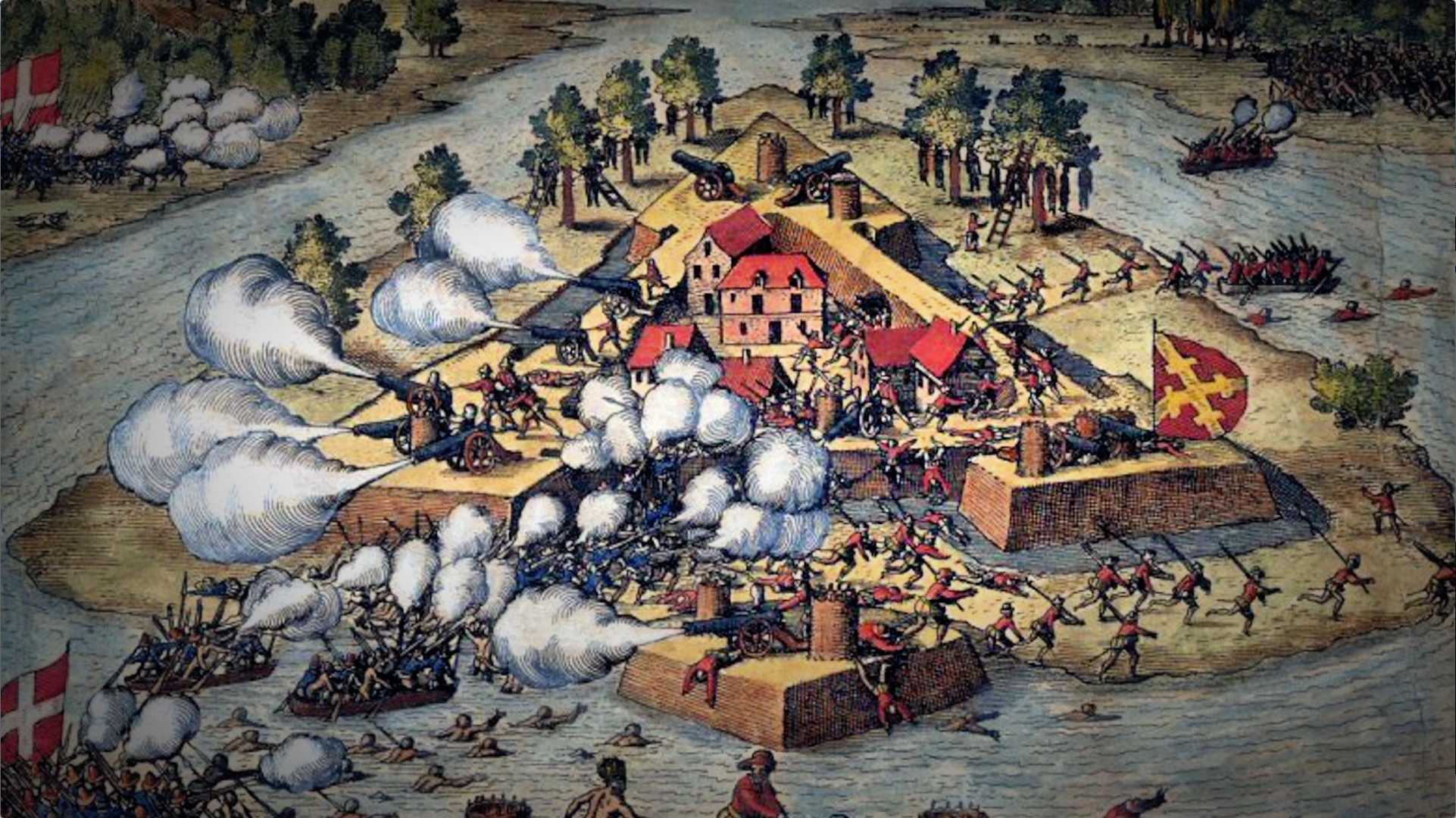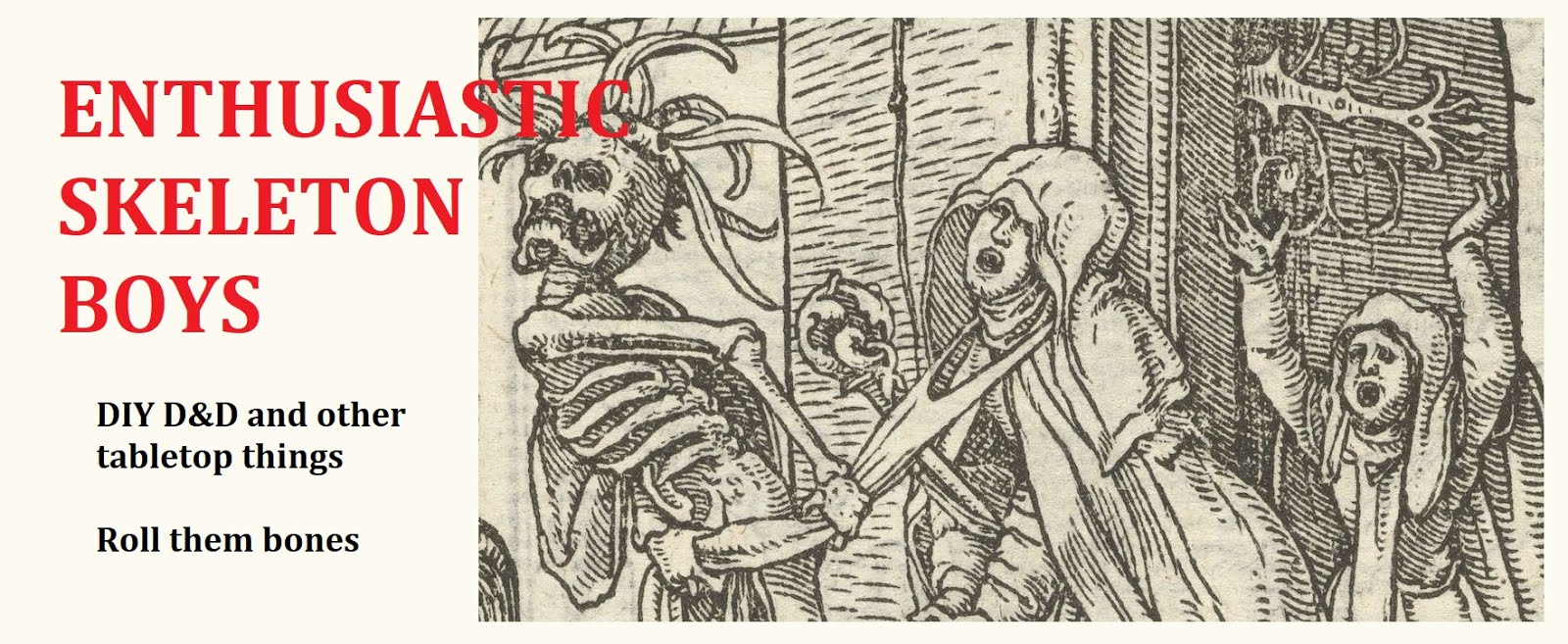 |
A post on Gundobad Games about adapting ItO for Domain-play pointed out solutions for scaling Detachments: to steal from Apocalypse World's lovely gang-system, which I've used before and loved.
Detachments and Size
The basic idea is that Detachments now have an additional size, based on the number of people in the unit.
Small (20+)
Medium (40+)
Large (80+)
Huge (160+)
So, two Small Detachments can combine to form a Medium one, two Medium Detachments can combine to form a Large etc etc.
This means I can still use ship stats with specific Crew Scores, as each point represents 20 sailors. So a Sloop with Crew Score 2 can field 2 Small Detachments, or merge everyone into a big angry Medium Detachment of pirates.
For every step of size advantage against a target, a Detachment gains +1 bonus dmg die, and +2 AV. (The base +1 dmg / +1 armour in AW is far too low, because it's based around a system where everything has about 6 HP)
Individuals attacking a Detachment suffer those size penalties, and deal impaired damage (d4) unless they use Area attacks. Detachments can hit multiple individuals at once.
Instead of HD reflecting size, the HD of a detachment is equal to the HD of a single member. Their damage die is based on equipment. Since there are 20 men per Small Detachment, you'd just multiply the cost of, say, a pistol, by 20 to equip them all with pistols.
So a Small Detachment of twenty HD3 Grenadiers wielding sabres would look like this:
Grenadier Detachment, HD3, Small, Sabres (d6)
If they go up against an individual PC, they gain +1 bonus dmg die and +2 AV, or:
Grenadier Detachment, HD3, Small, Sabres (2d6), AV2
Considering that individuals always deal impaired damage to Detachments without Blast weapons, that AV2 means there's a 50% chance that lone PC won't make a dent on the unit. But the reverse is true if the Grenadiers go up against 40 goblins: they'll be rolling 1d6 against AV2. Those are still better odds than that PC had, especially since those goblins are HD1 and have 3HP collectively.
If a Detachment is dropped to zero HP, they drop a size and Test Morale. I'm putting a placeholder 1d6 as the Morale Die for now, since Detachment HD doesn't scale that high. A Small Detachment dropped to zero HP is wiped out. This means that there are now 3 failure-states for Detachment-level warfare:
1) Detachment is destroyed (if it's small)
2) Detachment is reduced but stays in the fight
3) Detachment is reduced and flees / surrenders
 |
| Fortress rules |
Forts
Forts use similar principles. They're rare enough that I didn't mind assigning arbitrary HD values, but they all have a Size and additional AV based on the type of fortifications. This also makes it easier to make rulings on what happens if a Detachment were to eg, hole up in a tower. I'd give them either +AV2 or +AV3 depending on whether I thought the tower was closer to a palisade or stone walls.
As so:
EXAMPLE
|
SIZE
|
AV
|
STATS
|
SUPPLIES
|
Outpost
(20-man
Garrison)
|
Small
|
Sandbags (+AV1)
|
Level 2, d6
|
A few days
|
Wooden Fort
(100-man Company) |
Medium
|
Palisade (+AV2)
|
Level 4, d8
|
A week
|
Coastal
Fort
(400-man Battalion) |
Large
|
Stone Walls (+AV3)
|
Level 6, d10, Large-Scale
|
A few months
|
Star Fort
(1000-man Regiment) |
Huge
|
Reinforced Fort
(+AV4)
|
Level 8, d12, Large-Scale
|
Years
|
Forts would also benefit from Size advantages. It's suicide for a Small Detachment to attack a Star Fort: it has AV10 AND deals 3d12 damage relative to them.
PCs can attempt missions to lower individual stats: undermining the walls might lower AV, or sabotaging the powder stores might reduce that damage die. Forts should be very hard to take without subterfuge and advance planning, or a huge force-advantage. Or you could siege them.
Forts can create HD2 Detachments of their respective Sizes by reducing their HD by 2.
So a Coastal Fort could create a Large Detachment of HD2 soldiers, in exchange for being depleted to HD4. If an Outpost creates a Small Detachment, well, the whole garrison has up and left.
 |
| Ship Rules |
Ships follow the same Size principles. One exception is that Detachments need Cannon to attack a ship at all. Coastal Forts / Star Forts are assumed to have Cannons.
Ship Sizes are largely equivalent, except for the biggest warships/galleons. It's really there to enable them to interact with Detachments while still keeping manageable damage dice / hull points.
Don't mind all the stats here. The two damage values are the 'stock' and 'maximum' amount of guns. Crew values are probably too low, especially for Warships, but there's a separate sailing sub-system that uses Crew score and this current system leans towards play rather than simulation.
SHIP TYPE
|
Size
|
SPEED
|
MANVR.
|
HULL
|
GUNS
|
CREW (min. / MAX)
|
CARGO
|
Raiding Sloop
|
Medium
|
12
|
12
|
6
|
d4 / d8
|
1 / 2
|
4
|
Pirate Brig
|
Medium
|
11
|
11
|
12
|
d6 / 10
|
1 / 3
|
5
|
Merchant Junk
|
Medium
|
10
|
10
|
8
|
d4 / d8
|
1 / 3
|
6
|
Slave-Galley
|
Medium
|
8
|
8
|
16
|
d4 / d8
|
2 / 4
|
7
|
Galleon
|
Large
|
7
|
7
|
16
|
d8 / d12
|
1 / 3
|
9
|
Patrol Cutter
|
Medium
|
13
|
14
|
10
|
d6 / d8
|
1 / 2
|
3
|
Customs
Frigate
|
Medium
|
11
|
12
|
14
|
d8 / d10
|
1 / 3
|
4
|
Warship
|
Large
|
10
|
11
|
18
|
d10 / d12
|
2 / 4
|
5
|
 |
| Bring the noise |
You might have noticed the 'Large-Scale' tag in the Fort stats above. I'm still messing around with the terminology: I started with 'Ordnance', though I wondered whether 'Large-Scale' was more direct.
This directly addresses the troll-attacks-a-Detachment problem in the previous post. In Electric Bastionland, individuals deal d4 damage to Detachments unless they do Blast damage.
It's a sensible rule, which I've kept and renamed to the Area tag. This allows an individual creature to hit multiple opponents in 1-on-1 combat, or to keep their damage die in Detachment combat.
(Note: This tag is now very, very important for monsters that want to go up against large groups of foes. In my mind, it makes sense. If a big scary monster can only make 1 or 2 attacks a turn against individual foes, it's essentially the same as doing d4 damage against a Detachment of 20. Then the question is whether the monster can plink the Detachment to death, before they get through its hit-point sink.)
The next tool is the Large-Scale tag. This gives the benefits of the Area tag and allows attacks to ignore Size AV. It should be reserved for especially destructive weapons, like cannons, machine-guns or giant dinosaurs.
The final step is just to declare the creature so big that it's a Detachment itself, which is ItO's solution. Then you'd just run it using Detachment rules.
Test-Run:
So:
Tyrannosaurus Rex, HD10, Bite (2d10), Rampage (d6, Large-Scale)
Let's put him up against 20 brave (foolish?) dinosaur hunters.
Dinosaur Hunters, HD2, Small Detachment, Muskets (1d8)
The dinosaur hunters are a Small Detachment, so they'd do 2d8 damage, whilst the Rex does d6 but ignores Size AV. Considering HD2 is about 6 HP, the Rex would take around 2 rounds to eat through the hunters, and take 4d8 damage (or 4x4.5dmg), for an average of 18 points of damage. The Rex is wounded, but triumphant.
If 40 hunters got together, that would increase damage to 3d8. The Rex still takes 2 rounds to eat 20 hunters, but now takes around 6d8 damage (or an average of 27 points of damage). The 40 hunters might get lucky and take down the Rex in 1 round, but are more likely to get reduced by half, and have to Test Morale to see if the remaining 20 men break and run. The solution might be to buy them all armour, or hire better soldiers.
The exact numbers would need to be tweaked, but this seems workable.
I'd probably put Cannons at d10, Large-Scale. This also means that Detachments can take cannons off of ships, use the ship damage die, and just the Large-Scale tag.
Maybe cannons could default to the Size of their base ship if used by PCs in individual-scale combat? So a Sloop's culverin would do 3d4 damage if a PC really insisted on taking it with them, because a Medium Sloop gives +2 damage dice.
POSSIBLE PROBLEMS:
- What if a large army of soldiers armed with spears tries to attack a monster that is functionally a tank? The bonus damage dice would overwhelm natural armour, even though an individual spear wouldn't be able to pierce it. The easy solution is to multiply natural armour by number of damage dice, but at this point I can see my players' eyes glazing over.
- Large-scale tags scale downward, but not up. A Large detachment with cannons does 3d10 damage against a yeti, compared to the 2d10 of a Medium detachment. But both would do 1d10 to a Huge detachment. I'm ok with sacrificing this level of granularity.
- Does this system incentivize throwing together ludicrous numbers of peasants, indifferently arming them, and sending them against foes? ...Actually, is this a problem?



